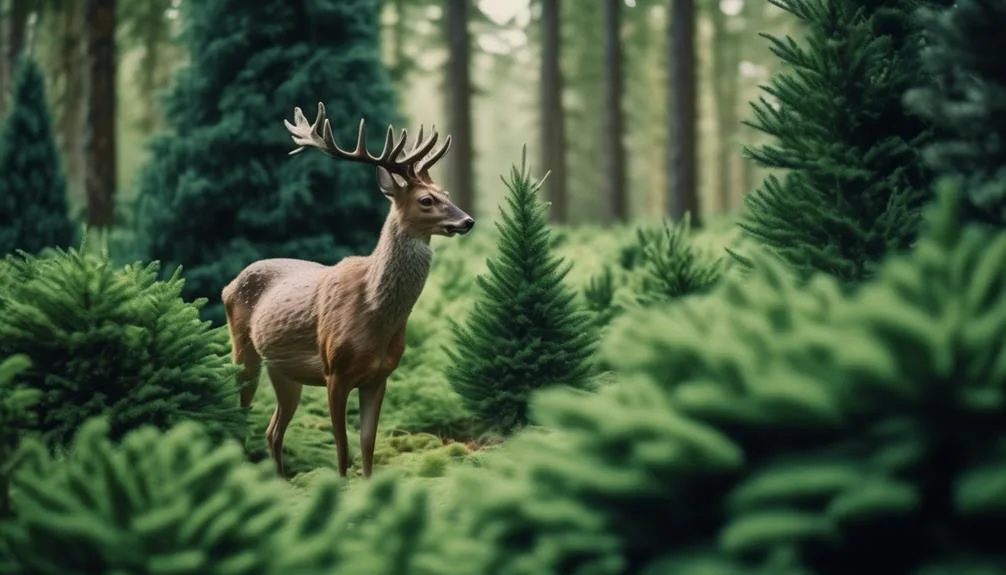Curious about whether Norway spruce trees are deer resistant?
Despite their popularity in landscaping and as Christmas trees, these majestic trees are not naturally deer resistant. Understanding the factors that make them susceptible to deer browsing and learning how to protect them can help in making informed decisions for your landscape.
Let's explore why Norway spruce trees attract deer and how to safeguard them from these voracious creatures.
Characteristics of Norway Spruce Trees
Norway Spruce trees boast a striking dark green color and a dense, conical shape, making them a popular choice for landscaping and windbreaks. These trees offer a range of benefits, including their ability to thrive in various environmental conditions and their resistance to deer. Their rapid growth patterns make them ideal for creating privacy screens or windbreaks.
To care for your Norway Spruce, ensure they've well-drained soil and receive adequate water and sunlight. Pruning can help maintain their shape and promote healthy growth. In landscaping, these trees are versatile, adding depth and texture to gardens, and serving as a stunning focal point.
Their environmental impact is significant, providing shelter for wildlife and contributing to the overall ecosystem. With proper care, Norway Spruce trees can be a valuable addition to your outdoor space.
Factors Affecting Deer Resistance
To enhance the deer resistance of your Norway Spruce trees, it's essential to understand the factors that contribute to their ability to deter deer.
Deer behavior plays a significant role in determining a tree's resistance. For instance, Norway Spruce trees are less appealing to deer due to their prickly needles and strong fragrance.
Additionally, the genetics of the tree also affect its deer resistance. Some trees have naturally evolved to produce compounds that are unappealing to deer, making them more resistant.
Understanding these factors can help you select the most deer-resistant trees for your landscape.
Deer Browsing Behavior and Norway Spruce
Understanding the factors that contribute to the deer resistance of Norway Spruce trees can provide valuable insights into how deer browsing behavior interacts with the tree's natural defenses. Deer are known to exhibit browsing behavior, often targeting the tender shoots and foliage of trees. When it comes to Norway Spruce, their prickly needles act as a deterrent, making it less palatable for deer to browse on them.
However, in times of food scarcity or high deer populations, these animals may still cause some damage to the lower branches of young spruce trees. It's important to consider the local deer population and their browsing behavior when planting Norway Spruce. By understanding these factors, tree damage can be minimized and the deer resistance of the trees can be maintained.
Methods to Protect Norway Spruce From Deer
In areas with high deer populations, implementing physical barriers such as fencing or tree shelters can effectively protect young Norway Spruce trees from browsing damage. When considering fencing options, sturdy wire or plastic mesh fencing at least 8 feet tall can deter deer from reaching the trees.
Electric fencing is also an effective option, delivering a mild shock to deter deer from approaching. Additionally, tree shelters made of plastic or mesh can provide individual protection for young saplings.
Repellent sprays, containing ingredients like putrescent egg solids or capsaicin, can also be applied to the trees to deter deer. These sprays should be reapplied according to the manufacturer's guidelines, especially after rain.
Landscaping Considerations for Deer-Resistant Trees
When planning your landscape, consider incorporating deer-resistant trees to minimize potential damage and maintenance efforts. When selecting trees for your landscape, keep in mind that deer-resistant trees can help manage wildlife and reduce the need for protective measures. Here are some landscaping considerations for deer-resistant trees:
- Choose trees with naturally aromatic foliage, such as the Colorado blue spruce or the Japanese cedar, to deter deer from browsing.
- Opt for trees with prickly textures, like the Japanese barberry or holly, as they're less appealing to deer.
- Consider trees with strong, flexible branches that can withstand mild deer browsing without sustaining significant damage, such as the American holly or the paper birch.
- Incorporate trees that are unpalatable to deer due to their bitter taste, such as the common boxwood or the Japanese pittosporum.
Conclusion
In considering the Norway spruce as a deer-resistant tree, it's essential to weigh factors such as local deer populations and seasonal food availability. By implementing the right precautions and landscaping strategies, you can safeguard the Norway spruce and appreciate its allure in your yard.
How can we better protect and preserve our natural surroundings amidst evolving environmental dynamics?

My interest in trees started when I first saw the giant sequoias in Yosemite.
I was a teenager then, and I remember thinking, “I need to learn more about this.”
That moment stuck with me.
A few years later, I went on to study forestry at Michigan Tech.
Since graduating, I’ve worked in a mix of hands-on tree care and community education.
I’ve spent over ten years helping people understand how to plant, maintain, and protect the trees in their neighborhoods.
I don’t see trees as just part of the landscape.
They are living things that make a real difference in our daily lives.
